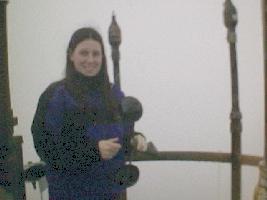 On a clear day, when Sarah Curtis installs windcups on the Mount Washington Observatory anemometer, she can see six states, two countries and the Atlantic Ocean. On a clear day.
On a clear day, when Sarah Curtis installs windcups on the Mount Washington Observatory anemometer, she can see six states, two countries and the Atlantic Ocean. On a clear day.
 Fridy, June 26, 1998, Mount Washington, New Hampshire -
Sarah Curtis actually enjoys working in the place known to have "the worst weather in the world" where, as far as we know, the temperature has never pushed above seventy-two degrees and it will snow every month of the year.
Fridy, June 26, 1998, Mount Washington, New Hampshire -
Sarah Curtis actually enjoys working in the place known to have "the worst weather in the world" where, as far as we know, the temperature has never pushed above seventy-two degrees and it will snow every month of the year. The strongest blast of wind ever recorded on this planet was up here in 1934 - howling at a numbing 231 mph. The greatest speed Curtis has recorded was 128mph and, where most people would pack up and leave after that, I sense that she is hanging around for even greater action.
At 6,288 feet, Mount Washington is not nearly one of the world's tallest. (In fact, over a quarter-million people stood on the peak last year, ascending by trail, rail or road.) Yet, over one hundred people have died while climbing this mountain, according to Peter Crane of the observatory. So why the miserable weather? Location. The White Mountains sit in the path of three major continental storm tracks, they lie broadside to the wind and they are close to the Atlantic Ocean.
Sarah Curtis checks the Hayes Chart Recorder, which prints wind speeds over time on a paper disc. To her right is the oldest barometer in the U.S. still in operation, built in 1941.
Check out a real
"Stormy Weather" recording.
Curtis works on the mountain for eight days straight, then returns to her home for six days off, taking the auto road up and down the mountain.
In winter, she rides the mountain in a Snow-cat, a large, agile, crawling machine with tank-like treads.
When the ice storm hit last winter and paralyzed much of the Northeast, it was life as usual at the top, except that the eight mile long access road was blocked by downed trees for several days. The Snow-cats could not get through, cutting off emergency services. It was not a good time to freak out up here.
Sarah Curtis starts her workday at 4am. She will prepare weather reports and take readings for the next few hours. During the morning rush hour, New England commuters rely on Curtis for weather reports via three radio stations. She will also transmit a report to radios installed in camping huts on the mountain for climbers to plan their days. So, even though she lives and works atop a mountain in a lonely concrete bunker, she directly affects the lives of thousands of people and when I mention her name elsewhere in the state, people know of her.
Through the day, Curtis will monitor the weather, take readings, write reports, maintain equipment and give tours to observatory members and errant journalists. The hourly readings require her to climb steel steps up a concrete tower to the observation deck. Things can get very routine around here.
Nicole Plette, handling the more tedious work of recording the world's worst weather. Those white curtains are white, but they're not curtains.
Computers in the observatory provide redundant data for weather monitoring. Find what the weather is like right now on top of Mt. Washington, in New Hampshire at the
observatory's web site.
Also find interesting information about the mountain and about becoming a member of the observatory.
To measure precipitation, Curtis will place a metal canister outside, it is about three feet tall and ten inches wide and it must be placed far away from everything else. Every six hours she will climb up to the deck, leave the safety of the concrete building and walk about one hundred feet carrying the empty "precip can." She will switch it with one that has been out for six hours and then try and find her way back in.
Some days are pretty nice up here (like the day of my visit, with at least fifteen feet of visibility) but sometimes you can't even see your toes, and the wind will whip and tear at your clothing and the rain will stab at what skin you were foolish enough to leave bare. It can cut into your psyche.
"The weather plays mind games on you," Curtis says, recalling an eerie experience one day during zero visibility conditions. "I was out changing the precip can and when I turned around, I couldn't see the landmark to get me back, only a few feet away. I thought 'whoa, it was there just two seconds ago!' I had almost believed it had disappeared."
Curtis has been one of the lucky few people who have experienced "Saint Elmo's Fire" by being so close to a lightning strike that she could hear the crackling of the air just before the bolt struck - lucky to have survived it, that is. How does she describe this part of her job, working in a place with winds so powerful they make the two-foot thick, concrete floor tremble? "It's dangerous, but it's exhilerating."
You go, girl.
At 4pm she hands the bridge over to the night shift and heads downstairs, trading exhileration for a little R & R.
Below the observatory weather room are the living and meeting quarters for observers, interns, volunteers, members and visiting professionals. If you love talking to people about the weather, come on up here.
If it isn't made of concrete or stone, secure it with two-inch chain, or don't try to put it atop Mount Washington.
A small relaxation area is bordered on one wall by a large bookcase and has pine furniture, a television, videos and other small comforts. A kitchen with a gas stove and a long dining table is where everybody congregates for dinner - an unwritten rule. Several bedrooms face this area, with bunk beds for up to fifteen people.
Sarah Curtis graduated from the University of Massachusetts at Lowell in 1997. She had interned here the summer before and she signed on full-time in August of last year. The qualifications for this position are much more than scholastic, including; social and independence skills, commitment and hardiness.
The isolation can be tough on a person with family, so the job attracts many younger people. How does Sarah cope?. "It wears on you, being up here for a week at a time and being away from the one you love," Sarah says. "I didn't think I'd be able to handle it, but at the same time you have to be able to deal with twenty dinner guests -- they sort of play off each other."
Curtis is not completely alone, though. There are two observers and two interns, a third intern runs an education program during which members
($25/yr. dues)
can stay overnight. One or two volunteers cook dinners and the only permanent resident in the observatory is a cat named Nin.
So does Sarah Curtis really like this Dream Job? (Some people might call it a "scream job.") Yes, she does. "I vowed to do something until I didn't enjoy it anymore," she says. "When I stop enjoying this, I'll move on."
Return to our



For other jobs to dream about while you're at work...
MAIN page
